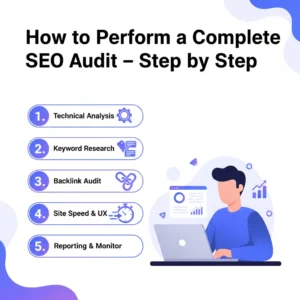In the fast-evolving world of digital marketing, understanding how to perform a complete SEO Audit has become a vital skill for any business that wants to grow online visibility and outperform competitors. As search algorithms become smarter and user behavior continues to shift, conducting regular SEO audits ensures your website stays optimized, fast, and fully aligned with best practices.
If you’re a business owner or marketer looking to understand what an SEO audit really involves — and how to do it effectively in 2025 — this guide is for you.

What Is an SEO Audit and Why It Matters
An SEO Audit is a comprehensive analysis of your website’s health and performance in search engines. It identifies issues that might be blocking your visibility on Google and other search platforms — from technical errors and poor mobile experience to missing keywords or weak backlinks.
A complete audit gives you a clear roadmap for improvement. It tells you what’s working, what’s not, and where to focus your time for the biggest impact.
You can learn more about SEO fundamentals in this guide: SEO Basics for Beginners.
Step 1: Crawl and Analyze Your Website
The first step in a complete SEO audit is to crawl your site the same way Google does. Tools like Google Search Console, PageSpeed Insights, or professional crawlers such as Screaming Frog can help you detect broken links, redirect chains, or pages blocked by robots.txt.
Checklist for this step:
-
Verify your sitemap and robots.txt are correct.
-
Check for crawl errors and server issues.
-
Ensure that every important page is indexable.
-
Review your site’s structure — make sure internal links are logical and easy to follow.
If you want a quick overview of what an audit should look like, check this helpful post: SEO Audit in 1 Hour.
Step 2: Evaluate On-Page SEO Elements
On-page SEO directly affects how your pages rank. This includes title tags, meta descriptions, headers, and keyword placement.
Best practices for on-page optimization:
-
Ensure each page has a unique, keyword-optimized title tag.
-
Write meta descriptions that are engaging and under 160 characters.
-
Use H1, H2, and H3 tags logically to organize content.
-
Include your primary keyword (like “SEO Audit”) naturally throughout the text.
-
Check for missing or duplicate content.
Dive deeper into these fundamentals with What Is On-Page SEO.
Step 3: Assess Site Speed and Mobile Experience
In 2025, website performance is more crucial than ever. Google prioritizes fast, mobile-friendly websites because they improve user experience and reduce bounce rates.
You can measure your site speed using tools such as:
-
Web.dev for in-depth performance audits
Check if your site meets Core Web Vitals benchmarks for:
-
Largest Contentful Paint (LCP) under 2.5 seconds
-
First Input Delay (FID) under 100 ms
-
Cumulative Layout Shift (CLS) under 0.1
To improve performance:
-
Optimize and compress images (see SEO for Images)
-
Minify CSS and JavaScript
-
Use a content delivery network (CDN)
-
Enable caching
Step 4: Review Your Keyword Strategy
Keywords remain the backbone of every SEO campaign. A successful audit checks if your content targets the right keywords — those that align with your audience’s search intent.
Tips for keyword evaluation:
-
Identify which keywords currently drive traffic using Google Analytics.
-
Analyze keyword gaps with competitors.
-
Check if your content matches the search intent (informational, navigational, or transactional).
For a structured approach, explore this Step-by-Step Guide to Keyword Research.
Step 5: Inspect Backlinks and Off-Page SEO
Backlinks remain a powerful ranking factor. A high-quality link profile shows Google that your site is trustworthy.
During your SEO audit:
-
Use tools like Ahrefs, SEMrush, or Moz to evaluate your backlink profile.
-
Identify toxic or spammy links and disavow them using Google Search Console.
-
Focus on acquiring authoritative backlinks through ethical link-building strategies.
You can learn practical link-building tactics here: Beginner’s Guide to Link Building.

Step 6: Audit Technical SEO and Structured Data
A technical SEO audit ensures your site is easy for search engines to crawl and understand. It includes checking site architecture, HTTPS security, canonical tags, schema markup, and more.
Technical SEO checklist:
-
Verify SSL certificates (HTTPS).
-
Ensure canonical URLs are in place to prevent duplicate content.
-
Use schema markup following Schema.org guidelines to enhance your rich results.
-
Review your XML sitemap and ensure it’s up-to-date.
-
Check for 404 errors and fix or redirect them (see this tip: Resolve the Dilemma of 404 Errors).
Step 7: Review Content Quality and Engagement
Search engines value high-quality, user-focused content. Analyze your pages to ensure they are informative, well-written, and up-to-date.
Key questions:
-
Does your content answer user intent?
-
Are your pages using visuals and internal links effectively?
-
Are blog posts optimized for engagement and readability?
A good resource for improving content is How to Optimize Blog Posts for SEO.
Step 8: Benchmark and Monitor Results
After completing your SEO audit, track your improvements over time. Use tools like Google Analytics and Google Search Console to monitor keyword performance, traffic trends, and technical fixes.
You can also stay updated with ongoing SEO insights by following SEO Top Secrets Blog, which publishes regular tips and SEO news.
Final Thoughts
Performing a complete SEO Audit in 2025 isn’t just about finding technical errors — it’s about understanding your audience, improving site experience, and creating content that genuinely serves users. By consistently auditing and refining your website, your business can stay ahead in search rankings and achieve sustainable growth.
For tailored strategies and professional support, explore our SEO services or learn more About Us.
Frequently Asked Questions (FAQ)
1. How often should I perform an SEO audit?
At least once every quarter. However, after major website updates or Google algorithm changes, a fresh audit is strongly recommended.
2. What tools do I need for an SEO audit?
Essential tools include Google Search Console, Google Analytics, and PageSpeed Insights. You can also use third-party tools like Ahrefs, SEMrush, or GTmetrix.
3. How long does a full SEO audit take?
Depending on the size of your site, it can take anywhere from 1 hour to several days. You can follow this fast method: SEO Audit in 1 Hour.
4. Can I do an SEO audit myself?
Yes! With the right tools and guidance, you can perform your own audit. Start by reading SEO Basics for Beginners.
5. What’s the most important part of an SEO audit?
There isn’t just one — success comes from balancing technical SEO, keyword strategy, and content optimization for users.
Ready to audit your site?
Start improving your rankings today with insights from SEO Top Secrets.


